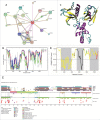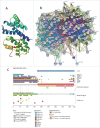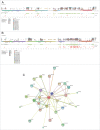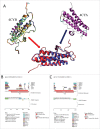Unreported intrinsic disorder in proteins: Disorder emergency room
- PMID: 28232885
- PMCID: PMC5314879
- DOI: 10.1080/21690707.2015.1010999
Unreported intrinsic disorder in proteins: Disorder emergency room
Abstract
This article continues an "Unreported Intrinsic Disorder in Proteins" series, the goal of which is to expose some interesting cases of missed (or overlooked, or ignored) disorder in proteins. The need for this series is justified by the observation that despite the fact that protein intrinsic disorder is widely accepted by the scientific community, there are still numerous instances when appreciation of this phenomenon is absent. This results in the avalanche of research papers which are talking about intrinsically disordered proteins (or hybrid proteins with ordered and disordered regions) not recognizing that they are talking about such proteins. Articles in the "Unreported Intrinsic Disorder in Proteins" series provide a fast fix for some of the recent noticeable disorder overlooks.
Keywords: disorder prediction; intrinsically disordered protein; intrinsically disordered protein region; molecular recognition; posttranslational modifications; protein-protein interactions.
Figures





Similar articles
-
Unreported intrinsic disorder in proteins: Building connections to the literature on IDPs.Intrinsically Disord Proteins. 2014 Dec 12;2(1):e970499. doi: 10.4161/21690693.2014.970499. eCollection 2014. Intrinsically Disord Proteins. 2014. PMID: 28232880 Free PMC article.
-
The alphabet of intrinsic disorder: II. Various roles of glutamic acid in ordered and intrinsically disordered proteins.Intrinsically Disord Proteins. 2013 Apr 1;1(1):e24684. doi: 10.4161/idp.24684. eCollection 2013 Jan-Dec. Intrinsically Disord Proteins. 2013. PMID: 28516010 Free PMC article. Review.
-
The intrinsic disorder alphabet. III. Dual personality of serine.Intrinsically Disord Proteins. 2015 Mar 17;3(1):e1027032. doi: 10.1080/21690707.2015.1027032. eCollection 2015. Intrinsically Disord Proteins. 2015. PMID: 28232888 Free PMC article. Review.
-
Disorder in the lifetime of a protein.Intrinsically Disord Proteins. 2013 Nov 7;1(1):e26782. doi: 10.4161/idp.26782. eCollection 2013 Jan-Dec. Intrinsically Disord Proteins. 2013. PMID: 28516024 Free PMC article.
-
A Comprehensive Survey of the Roles of Highly Disordered Proteins in Type 2 Diabetes.Int J Mol Sci. 2017 Sep 21;18(10):2010. doi: 10.3390/ijms18102010. Int J Mol Sci. 2017. PMID: 28934129 Free PMC article.
Cited by
-
An integrated understanding of the evolutionary and structural features of the SARS-CoV-2 spike receptor binding domain (RBD).Int J Biol Macromol. 2022 Sep 30;217:492-505. doi: 10.1016/j.ijbiomac.2022.07.022. Epub 2022 Jul 13. Int J Biol Macromol. 2022. PMID: 35841961 Free PMC article.
References
-
- Uversky VN. Digested disorder: quarterly intrinsic disorder digest (january/february/ march, 2013). Intrinsically Disordered Proteins 2013; 1:e25496; http://dx.doi.org/10.4161/idp.25496 - DOI - PMC - PubMed
-
- DeForte S, Reddy KD, Uversky VN. Digested disorder, issue #2: quarterly intrinsic disorder digest (april/may/june, 2013). Intrinsically Disordered Proteins 2013; 1:e27454; http://dx.doi.org/10.4161/idp.27454 - DOI - PMC - PubMed
-
- Reddy KD, DeForte S, Uversky VN. Digested disorder, issue #3: quarterly intrinsic disorder digest (july-august-september, 2013). Intrinsically Disordered Proteins 2014; 2:e27833; http://dx.doi.org/10.4161/idp.27833 - DOI - PMC - PubMed
-
- Obradovic Z, Peng K, Vucetic S, Radivojac P, Dunker AK. Exploiting heterogeneous sequence properties improves prediction of protein disorder. Proteins 2005; 61 7:176-82; PMID:16187360; http://dx.doi.org/10.1002/prot.20735 - DOI - PubMed
LinkOut - more resources
Full Text Sources
Other Literature Sources
